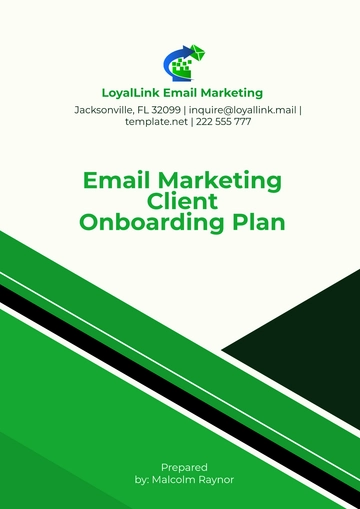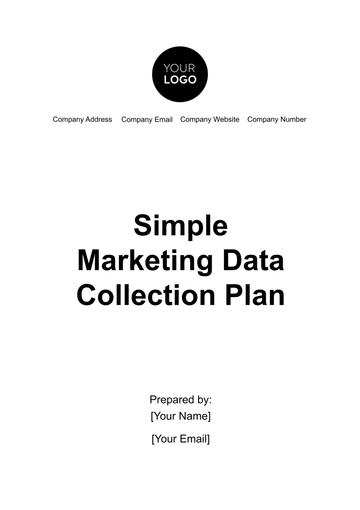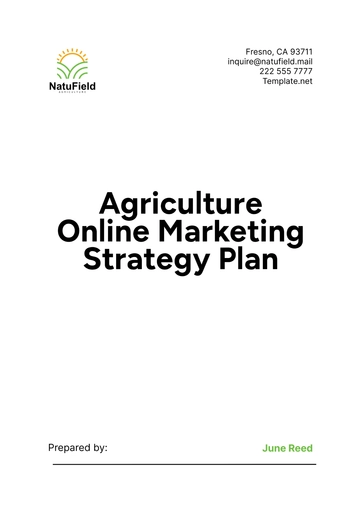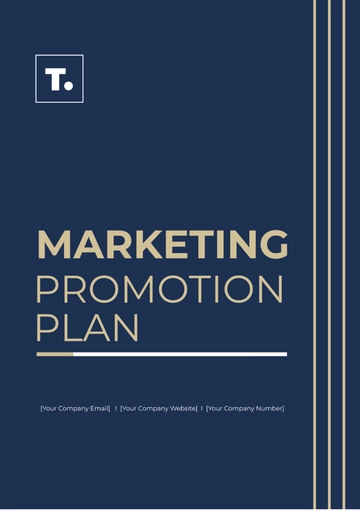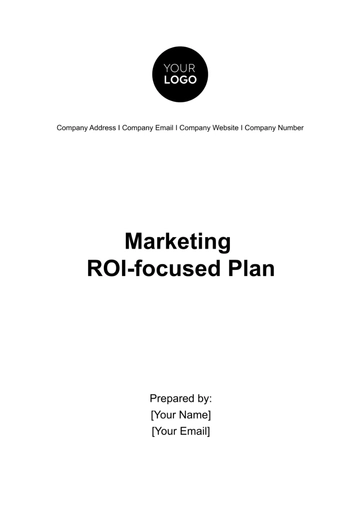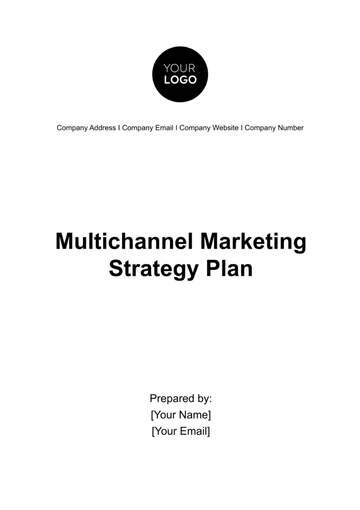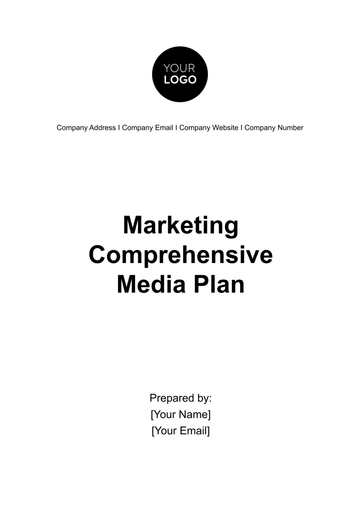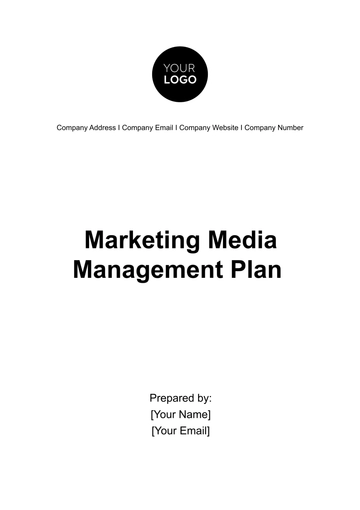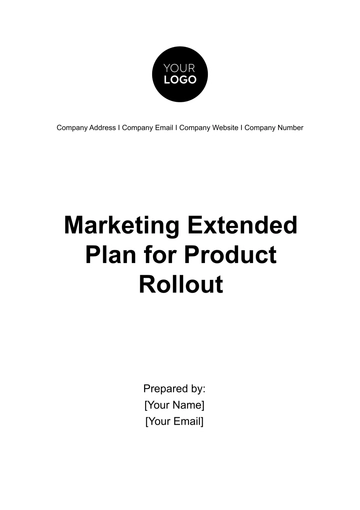Free Marketing Customer Persona Management Plan

Management Plan
1. Introduction
The purpose of this Marketing Customer Persona Management Plan is to offer a structured approach to identifying, understanding, and segmenting [Company Name]'s diverse customer base. Through this systematic exercise, we aim to craft detailed customer personas that encapsulate key demographics, psychographics, behavioral traits, and preferences of our various customer groups. By having this rich data at our fingertips, we can make more informed decisions about our marketing campaigns, content creation, and customer engagement strategies. The plan will employ an assortment of tools and methodologies for data collection and analysis, ranging from digital analytics to customer interviews. Additionally, we intend to use various communication channels tailored specifically for each persona to maximize reach and engagement. The overarching goal is not merely to throw a wide net but to cast it intelligently, ensuring that each marketing dollar spent is optimized for the highest possible return on investment (ROI). In summary, this plan serves as a roadmap to enhance the effectiveness and efficiency of our marketing efforts, thereby fostering stronger customer relationships and boosting overall revenue.
2. Objectives
Develop Comprehensive Customer Personas. The first objective is to develop exhaustive customer personas that will serve as archetypes for our varied customer base. These personas will be created through meticulous data collection, including customer interviews, surveys, and behavioral analytics. The objective is not merely to identify who our customers are but to understand their pain points, needs, and preferences in-depth. With this understanding, we can customize our products, services, and messaging to meet these specific needs, thereby driving engagement and revenue.
Achieve 20% Improvement in Targeted Marketing Efficacy. Our second objective aims to improve the efficacy of our targeted marketing campaigns by 20%. With the help of the comprehensive customer personas developed, we will redesign our marketing campaigns to resonate better with specific customer segments. We'll employ A/B testing to fine-tune our approaches, optimizing for higher conversion rates and increased customer engagement. This is a quantitative goal; we aim to see a significant improvement in key performance indicators like click-through rates, engagement rates, and conversion rates.
Decrease Marketing Costs by 10% Through Precise Targeting. Cost-efficiency is an essential aspect of our strategy. Our third objective focuses on reducing overall marketing expenditure by 10% through precision targeting. By fully understanding our customer personas, we can allocate resources more wisely, focusing on channels and mediums that yield the highest ROI. This strategy will eliminate wasteful spending on broad, untargeted campaigns that do not effectively reach our desired audience. This budget cut is expected to happen without compromising on the quality or reach of our marketing activities.
Increase Customer Retention by 15% Within a Year. The final objective is geared towards improving customer loyalty and retention by 15% within the next year. Retaining existing customers is often more cost-effective than acquiring new ones. With the help of our detailed customer personas, we plan to develop specialized retention programs, including loyalty rewards and personalized communications, to increase customer satisfaction and encourage repeat business. We aim to monitor customer satisfaction through periodic surveys and net promoter score (NPS) evaluations, thereby continuously adapting our strategies to meet and exceed customer expectations.
3. Customer Persona Categories
Understanding the different categories of customers is crucial for any marketing strategy. This chapter provides an overview of the customer persona categories that are most pertinent to [Company Name]. These personas—Young Professionals, Small Business Owners, and Corporate Executives—will guide our marketing efforts, from content creation to channel selection. Each persona represents a distinct segment of our audience, complete with unique needs, interests, and preferences. Having a detailed understanding of each category allows us to tailor our strategies for maximum impact.
Customer Persona | Age Range | Income Range | Key Interests | Preferred Channels |
Young Professionals | 24-35 | $50k - $100k | Career growth, technology, travel | Social Media, Blogs |
Small Business Owners | 30-50 | $100k - $500k | Business growth, investments, networking | Webinars, Industry Reports |
Corporate Executives | 40-60 | $200k+ | Strategic partnerships, industry trends | LinkedIn, Whitepapers |
By employing this table format, we encapsulate the vital details about each customer persona in a clear, concise manner, offering an at-a-glance overview that can be easily referenced during strategy meetings and campaign planning.
4. Data Collection Strategies
In the realm of customer persona management, one of the most critical steps is effective data collection. This chapter delves into the various methods we will employ to gather essential information that will form the foundation of our customer personas. These data collection strategies are carefully chosen to encompass a wide range of sources and techniques, aiming for a holistic understanding of our customer base. This will involve employing Online Surveys, Customer Interviews, Social Media Polls, and Sales Data Analysis, each contributing a unique set of insights to our overall strategy.
Online Surveys. Online surveys are a convenient and scalable way to gather quantitative and qualitative data directly from a broad customer base. These surveys will consist of a mix of multiple-choice questions, Likert scales, and open-ended questions. They will be distributed through our email newsletters, within our app, and on our website. The objective is to gauge customer preferences, pain points, and behavioral tendencies, among other metrics. The anonymity of online surveys often encourages more honest and candid responses, adding to the reliability of the collected data.
Customer Interviews. Customer interviews provide an opportunity for a deeper, qualitative understanding of our customers. These interviews will be conducted either in-person or via video calls, depending on the respondent's location and convenience. We aim to discuss in detail the customer's experiences with our products or services, their pain points, and their motivations for choosing [Company Name]. The insights derived from these interviews are often nuanced and offer perspectives that surveys and other data collection methods may not capture. Therefore, customer interviews are essential for forming well-rounded customer personas.
Social Media Polls. Utilizing social media platforms provides an informal and interactive way to gather data. Polls on platforms like Facebook, Twitter, and Instagram can be used to ask specific questions about product preferences, lifestyle choices, and more. The advantage of social media polls is that they are highly engaging and can be completed quickly by respondents, allowing us to collect data in real-time. However, it's important to note that this method may skew toward a younger and more tech-savvy audience, so the results should be interpreted in the context of the broader data collection strategy.
Sales Data Analysis. Sales data analysis involves scrutinizing historical sales records to identify buying patterns, customer demographics, and other valuable metrics. Tools like Salesforce and custom analytics dashboards will be used for this purpose. By understanding who our actual paying customers are, as opposed to prospective or one-time customers, we can create more targeted and effective marketing campaigns. Sales data is a goldmine of insights into what drives purchases, customer lifetime value, and product preferences, making it an indispensable part of our data collection strategy.
By leveraging these four data collection methods in conjunction, we aim to construct a multifaceted view of our customer base. This amalgamation of insights will not only enrich our customer personas but will also enable us to tailor our marketing strategies more precisely, ensuring better alignment with customer needs and preferences.
5. Data Analysis and Segmentation
Once the data is collected, the next pivotal step is to analyze and segment this information to create actionable insights. This chapter outlines the metrics we will focus on and the tools we will utilize for this purpose. The combination of these metrics—Age, Income, Interests, and Engagement—will help us construct a multidimensional view of our customer personas. Accurate analysis and segmentation are crucial for optimizing our marketing strategies and achieving higher ROI. This chapter serves as a guide to understanding the metrics to track and the tools to use for effective data analysis and customer segmentation.
Metrics and Analysis Tools
Metrics | Analysis Tools | Description | Why Chosen |
Age | Google Analytics | Age demographics help in understanding the life stage and priorities of our customers. | Allows for age-specific marketing strategies. |
Income | Salesforce | Income levels are vital for segmenting customers based on their spending power. | Enables tailored offers and promotions. |
Interests | Surveys | Knowing customer interests aids in crafting relevant content and promotions. | Facilitates targeted marketing, improving engagement. |
Engagement | Hootsuite | Engagement metrics measure the interaction levels of customers with our marketing channels. | Helps in understanding the effectiveness of campaigns. |
6. Content Mapping
In the dynamic landscape of digital marketing, the 'one-size-fits-all' approach is increasingly less effective. To maximize engagement and conversion rates, it's imperative to align the type of content with the unique characteristics of different customer personas and the platforms where they are most active. This chapter—Content Mapping—addresses precisely that. Here, we lay out a detailed roadmap that specifies what types of content resonate best with our key customer personas—Young Professionals, Small Business Owners, and Corporate Executives—and the platforms where these content types should be disseminated. By aligning these elements, we aim to provide highly tailored content that not only speaks directly to the unique needs and interests of each customer segment but also leverages the most effective channels for distribution.
Customer Persona | Content Type | Platform |
Young Professionals | Blogs | Medium, Company Blog |
Small Business Owners | Webinars | YouTube, Zoom |
Corporate Executives | Whitepapers | LinkedIn, Company Website |
7. Channels and Mediums
The channels and mediums through which we distribute our content play an essential role in reaching our target audience and achieving our marketing objectives. This chapter, "Channels and Mediums," will focus on identifying the most effective avenues for engaging with our customer personas—Young Professionals, Small Business Owners, and Corporate Executives. Specifically, we will delve into Social Media, Company Blog, Webinars, and Email Marketing as our primary channels. We aim to select the channels that are best suited for each type of content and customer persona to maximize reach, engagement, and ROI.
Channels and Mediums Explored:
A. Social Media
Social Media platforms like Facebook, Instagram, Twitter, and LinkedIn are versatile tools for reaching a wide and varied audience. For Young Professionals, platforms like Instagram and Twitter can be highly effective for quick, visually appealing content. Corporate Executives, on the other hand, are more likely to engage with in-depth content on LinkedIn. Social Media enables us to tailor our message according to the platform and the audience it attracts.
B. Company Blog
Our Company Blog serves as a hub for longer, more in-depth articles that cater to all our customer personas but are particularly useful for engaging Young Professionals who are interested in career growth and technology. Blogs allow us to establish [Company Name] as a thought leader in the industry, offer value to our customers, and improve our search engine rankings, all while building brand loyalty.
C. Webinars
Webinars offer real-time engagement and are particularly beneficial for Small Business Owners looking for business growth strategies, investment tips, or networking opportunities. Platforms like YouTube and Zoom allow for easy access and interaction, making it more convenient for this busy demographic. Additionally, webinars provide an opportunity for lead generation through sign-ups and can be repurposed into multiple content formats post-event.
D. Email Marketing
Email Marketing remains one of the most effective channels for personalized, targeted communication. This method is particularly effective for Corporate Executives who may prefer receiving in-depth whitepapers, case studies, or industry insights directly to their inbox. Email marketing allows us to segment our audience based on various parameters like age, income, and engagement levels, enabling highly targeted campaigns that yield better results.
By understanding and leveraging the strengths of these channels and mediums, [Company Name] aims to create a seamless and effective content distribution network. This strategic approach ensures that we meet our customers where they are, delivering the right content at the right time, thereby increasing engagement and driving business goals.
Timeframe and Milestones
In any marketing strategy, timing is everything. Without a well-defined schedule and clear milestones, even the most well-thought-out plans can go astray. This chapter, "Timeframe and Milestones," aims to provide a chronological roadmap that outlines key stages and deadlines for our Marketing Customer Persona Management Plan. From data collection to campaign launch, each milestone serves as a critical checkpoint that helps us gauge our progress, reevaluate our strategies if necessary, and stay on track toward achieving our objectives. This structured timeline will guide [Company Name] in its journey to effectively understand, categorize, and market to its diverse customer base.
Date [MM/YYYY] | Milestone |
[01/2024] | Data Collection Complete |
[03/2024] | Initial Analysis Complete |
[06/2024] | Content Development |
[09/2024] | Campaign Launch |
Budget
Resource allocation is a crucial component of any successful marketing plan. It provides a financial blueprint that outlines the cost implications of each activity, thereby ensuring a balanced and sustainable approach to achieving our marketing goals. This chapter, titled "Budget," details the financial requirements for implementing our Marketing Customer Persona Management Plan. It breaks down the costs associated with Data Collection Tools, Content Creation, Marketing Platforms, and Monitoring and Reporting Tools. By explicitly outlining these financial commitments, we aim to provide stakeholders with a transparent view into the necessary investments. This will enable [Company Name] to allocate resources efficiently and ensure that the plan is both actionable and financially viable.
Item | Cost [$] |
Data Collection Tools | [5,000] |
Content Creation | [10,000] |
Marketing Platforms | [15,000] |
Monitoring and Reporting Tools | [2,000] |
Total | [32,000] |
Monitoring and Reporting
Consistent monitoring and periodic reporting are essential for understanding the effectiveness of our marketing strategies and making data-driven adjustments. This chapter, "Monitoring and Reporting," delineates the types of reports that [Company Name] will regularly generate and analyze to evaluate our marketing efforts. Specifically, we will focus on Monthly KPI Reports, Quarterly ROI Analysis, and Annual Customer Feedback. This structured approach to monitoring and reporting ensures that we keep track of key performance indicators, measure our returns on investments, and incorporate customer feedback for ongoing improvements.
Monitoring and Reporting Mechanisms:
A. Monthly KPI Reports. Key Performance Indicators (KPIs) such as website traffic, engagement rates, and conversion ratios offer real-time insights into how well our marketing strategies are working. These KPI reports will be generated monthly to provide a consistent and current view of our performance. Monthly reports enable timely adjustments to our strategies, ensuring we are always moving towards our objectives effectively.
B. Quarterly ROI Analysis. Measuring the Return on Investment (ROI) is crucial for evaluating the financial effectiveness of our marketing initiatives. Every quarter, we will perform a comprehensive ROI analysis that will consider various factors including but not limited to, customer acquisition costs, customer lifetime value, and sales growth. Quarterly reviews offer a balanced frequency, enabling us to identify trends, make data-backed decisions, and justify or modify budget allocations as needed.
C. Annual Customer Feedback. Customer feedback serves as a qualitative measure of our marketing effectiveness. Once a year, we will conduct customer surveys, focus groups, or interviews to gauge customer satisfaction, needs, and preferences. This Annual Customer Feedback mechanism will not only provide insights into customer perceptions but also highlight areas for improvement in our product offerings and marketing strategies.
By diligently monitoring these KPIs, conducting ROI analyses, and gathering customer feedback, [Company Name] aims to create a feedback loop that informs and refines our marketing strategies. Through these practices, we can continually adjust our approaches, optimize our budget allocation, and better serve our target customer personas.
Conclusion
This plan aims to guide [Company Name] through the process of understanding, categorizing, and ultimately targeting its customer base in a more effective and cost-efficient manner.
Appendix
Customer Persona Templates (Attachment)
Sample Surveys (Attachment)
Prepared By: [Your Name]
Contact Information: [Your Contact Information]
Date: [Today’s Date]
Approved By: [Manager's Name]
Date: [Approval Date]
- 100% Customizable, free editor
- Access 1 Million+ Templates, photo’s & graphics
- Download or share as a template
- Click and replace photos, graphics, text, backgrounds
- Resize, crop, AI write & more
- Access advanced editor
Maximize your marketing impact with Template.net's Marketing Customer Persona Management Plan Template. This editable and customizable tool empowers you to craft detailed customer personas tailored to your audience. Edit effortlessly in our Ai Editor Tool, ensuring precision in your targeting strategies. Elevate your marketing game with this essential resource.
You may also like
- Finance Plan
- Construction Plan
- Sales Plan
- Development Plan
- Career Plan
- Budget Plan
- HR Plan
- Education Plan
- Transition Plan
- Work Plan
- Training Plan
- Communication Plan
- Operation Plan
- Health And Safety Plan
- Strategy Plan
- Professional Development Plan
- Advertising Plan
- Risk Management Plan
- Restaurant Plan
- School Plan
- Nursing Home Patient Care Plan
- Nursing Care Plan
- Plan Event
- Startup Plan
- Social Media Plan
- Staffing Plan
- Annual Plan
- Content Plan
- Payment Plan
- Implementation Plan
- Hotel Plan
- Workout Plan
- Accounting Plan
- Campaign Plan
- Essay Plan
- 30 60 90 Day Plan
- Research Plan
- Recruitment Plan
- 90 Day Plan
- Quarterly Plan
- Emergency Plan
- 5 Year Plan
- Gym Plan
- Personal Plan
- IT and Software Plan
- Treatment Plan
- Real Estate Plan
- Law Firm Plan
- Healthcare Plan
- Improvement Plan
- Media Plan
- 5 Year Business Plan
- Learning Plan
- Marketing Campaign Plan
- Travel Agency Plan
- Cleaning Services Plan
- Interior Design Plan
- Performance Plan
- PR Plan
- Birth Plan
- Life Plan
- SEO Plan
- Disaster Recovery Plan
- Continuity Plan
- Launch Plan
- Legal Plan
- Behavior Plan
- Performance Improvement Plan
- Salon Plan
- Security Plan
- Security Management Plan
- Employee Development Plan
- Quality Plan
- Service Improvement Plan
- Growth Plan
- Incident Response Plan
- Basketball Plan
- Emergency Action Plan
- Product Launch Plan
- Spa Plan
- Employee Training Plan
- Data Analysis Plan
- Employee Action Plan
- Territory Plan
- Audit Plan
- Classroom Plan
- Activity Plan
- Parenting Plan
- Care Plan
- Project Execution Plan
- Exercise Plan
- Internship Plan
- Software Development Plan
- Continuous Improvement Plan
- Leave Plan
- 90 Day Sales Plan
- Advertising Agency Plan
- Employee Transition Plan
- Smart Action Plan
- Workplace Safety Plan
- Behavior Change Plan
- Contingency Plan
- Continuity of Operations Plan
- Health Plan
- Quality Control Plan
- Self Plan
- Sports Development Plan
- Change Management Plan
- Ecommerce Plan
- Personal Financial Plan
- Process Improvement Plan
- 30-60-90 Day Sales Plan
- Crisis Management Plan
- Engagement Plan
- Execution Plan
- Pandemic Plan
- Quality Assurance Plan
- Service Continuity Plan
- Agile Project Plan
- Fundraising Plan
- Job Transition Plan
- Asset Maintenance Plan
- Maintenance Plan
- Software Test Plan
- Staff Training and Development Plan
- 3 Year Plan
- Brand Activation Plan
- Release Plan
- Resource Plan
- Risk Mitigation Plan
- Teacher Plan
- 30 60 90 Day Plan for New Manager
- Food Safety Plan
- Food Truck Plan
- Hiring Plan
- Quality Management Plan
- Wellness Plan
- Behavior Intervention Plan
- Bonus Plan
- Investment Plan
- Maternity Leave Plan
- Pandemic Response Plan
- Succession Planning
- Coaching Plan
- Configuration Management Plan
- Remote Work Plan
- Self Care Plan
- Teaching Plan
- 100-Day Plan
- HACCP Plan
- Student Plan
- Sustainability Plan
- 30 60 90 Day Plan for Interview
- Access Plan
- Site Specific Safety Plan
